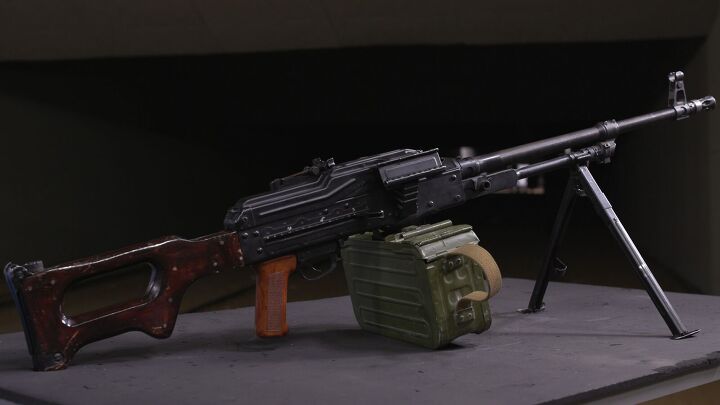https://cdn-fastly.thefirearmblog.com/media/2024/09/16/10061/the-history-of-pkm-the-most-common-machine-gun-in-the-world-part-1.jpg?size=720×845&nocrop=1
Everyone knows AK-47. It is everywhere: movies, books, crime statistics. Interestingly enough, those who spend some time in the warzone often have stronger feelings towards another Kalashnikov creation – the PK/PKM belt-fed machine gun.
Some say that PK is the best weapon Kalashnikov ever created. While AK was developed at the very beginning of his career, PK was created when Kalashnikov had plenty of experience.
Millions of those machine guns are used all over the world, US special forces requested American companies to produce those guns multiple times, and some experts call it “the best general purpose machine gun”.
However, few people know that it was created almost by accident. There are many great articles on AK history, but there is almost nothing published in English about the PK development, and hopefully, this article can fix that.
How it all started
The summer of 1959 was a busy time for Mihail Kalashnikov. The new family of weapons he designed, which included AKM and RPK light machine guns, was just getting into production. He had to prove for the second time in his career that his rifle was the best.
First, his AK 47 won the competition in 1949, and ten years later his other creation, AKM bested all rivals and now was destined to become the new service rifle of the Soviet Army and most Warsaw Pact countries.
Kalashnikov hadn’t had a vacation in 4 years. That summer there was finally an opportunity to celebrate, and it was all more convenient that his old friend visited him in the city of Izhevsk.
The old friend was army officer Vladimir Deikin, who was one of the people who made AK happen. The officer of GRAU, the military department responsible for procurement of new weaponry, he supported Kalashnikov all the way through the development of the original AK rifle, ruthlessly crushing bureaucracy and red tape that got in the way of a young weapon design engineer.
As the years went by, a young and shy Kalashnikov became the most respected weapon designer in the Soviet Union, and Vladimir Deikin became a colonel, rising to the top of the career ladder.
That summer two friends who have been through a lot could finally enjoy their life. They took a boat and went fishing, invited friends from the factory, and spent the weekend in a cabin on the lake, talking about guns and cooking fish they caught.
Before leaving, Vladimir Deikin nonchalantly shared some news: “This guy Nikitin at the factory in Tula is developing GPMG (general purpose machine gun). The trials are almost over, it adheres to the requirements… But in GRAU we think it is a little too complicated. The army needs something more simple”.
He didn’t ask Kalashnikov to get involved. He never asked for help. But he knew his old friend and realized, Kalashnikov won’t just leave it alone. Now, after his friend left, Kalashnikov had a whole bunch of questions.
Why wasn’t I asked to develop this new GPMG? Why don’t they trust me? Am I in trouble? How complicated is too complicated? Will they ask me to redesign this gun once it finishes trials? Or is it the end of my career?
The brainstorming
Kalashnikov decided that he must do something about it. He already had a team of engineers and enough authority to build a machine gun from scratch without asking permission.
There was no money allocated for this project, but he could pull some strings and use money from his other projects to finance the ammo and all the prototype building.
He became obsessed with his new machine gun and completed the first sketches in just ten days. However, drawings alone are no good, you need to make blueprints, which Kalashnikov couldn’t really do – he was never formally educated and always relied on someone else to make blueprints.
In this case, engineer Krupin was tasked with creating proper blueprints, and the entire team got on with the project. The rival machine gun from Tula was already undergoing troop trials, the Ministry of Industry never asked for another contender, but Kalashnikov decided that he would deal with that another day.
The obsession Kalashnikov had was contagious, engineers were staying at work until 5 in the morning, and within weeks they started making the first parts of the prototype.
Often, there was no time to make proper blueprints, so engineers just winged it, making parts on the lathe and milling machine relying solely on their imagination and some sketches.
Within a month, the first prototype of PKM was ready. Now Kalashnikov just had to convince the entire Soviet military-industrial complex that his crude prototype was better than a machine gun that already passed all the trials and ticked all the boxes. How did he manage to do that? That is the story for Part 2 of this article.
The Firearm Blog





